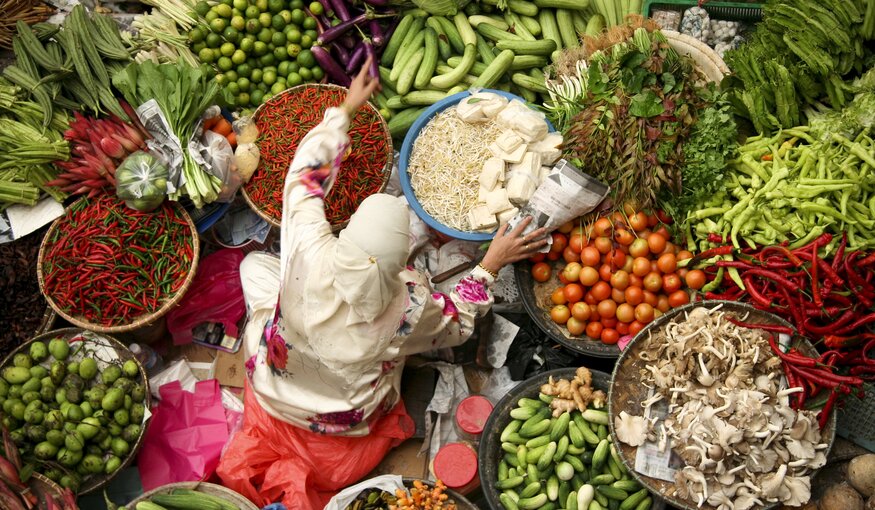The Crop Trust Aims High With 2030 Strategy Plan for Genebanks

9 November 2023
“You’ve got to think about doing big things while you’re doing small things, so that all the small things go in the right direction.”
The words of U.S. futurist writer Alvin Toffler in the 1970s are sometimes cited in business and technology circles to highlight the importance of pursuing a long-term goal while achieving short-term objectives. No doubt, a good strategy must have a far-reaching vision that lends broader significance to day-to-day operations, in the same way that a tapestry gives meaning to its constituent threads.
In agriculture, big, forward-looking thinking is the only way to meet the myriad challenges of climate change and adapt to its effects. This includes developing resilient crop varieties that can withstand higher temperatures, increasingly frequent weather extremes, and the growing threat of pests and disease in the years to come, and getting them into farmers’ fields.
To be able to do that big, complicated thing, however, we need to do a relatively small, easy thing: put as many seed samples in the world’s genebanks. We must urgently conserve the rapidly disappearing crop diversity that supports our food systems and provides scientists and farmers with options. Because once a crop variety is extinct, it’s gone forever. And the options it represented are also gone.
Genebanks—where different varieties of crop seeds are stored and made available to users—must be upgraded and maintained around the world to provide farmers and breeders with access to the seeds that they need to produce food, forever. Without these lifelines of agriculture, humanity faces an uncertain future, with fewer opportunities to adapt to the realities of climate change.
The Crop Trust has long recognized that the many conservation activities we engage in today contribute to the “big picture” of food security over the long term. To chart a steady course toward a resilient future, we recently developed a strategic plan that will guide the organization and its partners through to 2030.
Three Goals
Food Forever: Crop Trust 2030 Strategic Plan focuses on three overarching institutional goals to help realize the vision of a world in which crop diversity is permanently conserved and made available in support of sustainable, resilient and healthy agri-food systems.
First, we will provide long-term financial assistance for the essential operations of all genebanks that have signed agreements with the Plant Treaty under Article 15. We will also assist additional international genebanks that hold unique, globally significant crop diversity collections in the Multilateral System, meet agreed performance standards, and require external funding.
The highest priority will be assigned to these international genebanks and the Svalbard Global Seed Vault, which is the ultimate backup storage facility for crop diversity that can be conserved as seeds over the long term.
Second, the Crop Trust will significantly increase time-bound support for: (i) upgrading facilities in national genebanks; (ii) monitoring threats to crop diversity and conserving threatened crop diversity in genebanks; and (iii) enhancing the availability of crop diversity by bolstering linkages between genebanks and their users.
Third, we will significantly increase global awareness of the importance of crop diversity, while broadening and deepening institutional partnerships. Through strategic communications and outreach, the Crop Trust aims to move crop diversity much, much higher on the global development agenda by 2030. It’s hardly visible now. That needs to change.
International cooperation is vital to the conservation and availability of crop diversity. No country in the world is self-sufficient in this regard. In most countries, consumed calories come mainly from crops that originated—and whose diversity is mostly located—elsewhere. Consequently, the Crop Trust intends to focus more on how genebanks work together and with their users, moving toward a Global Genebank Partnership.
Fundraising Targets
To do all of this, the Crop Trust needs more financial resources. We are therefore seeking additional support on the path to achieving the three goals of our strategic plan by the end of the decade. This means boosting the value of our Endowment Fund.
To promote the long-term conservation of crop diversity in international genebanks, a total of USD 74.4 million was withdrawn from the income of the Endowment Fund during the period 2005–2022, thanks to donor contributions of more than USD 253 million.
Yet this funding is not sufficient to fully address the organization’s core mission: the endowment needs to be increased to yield USD 25 million annually as quickly as possible. To reach our targets by 2030, this means boosting the market value of the Endowment Fund to USD 625 million.
Ultimately, the Crop Trust aims to raise the value of the Endowment Fund to USD 850 million to ensure that the world’s crop diversity is available in perpetuity.
To support the growth of the Endowment Fund, the Crop Trust will continue to approach public donors, but will also reach out to private foundations as well as high-net-worth individuals and the corporate world. Innovative finance instruments will play an increasing role in raising funds.
With enough support, our strategic plan to 2030 will help us achieve the “big things” in the Crop Trust’s mission and ensure that the “small things” head in the right direction. Everyone will benefit if we can convert our futurist vision into reality: the permanent conservation of crop diversity and a world of sustainable, resilient and healthy agri-food systems.
Categories: For Partners, Climate Change, Environmental Restoration, Food Security, Nutritional Security, Poverty Reduction, Sustainable Agriculture


